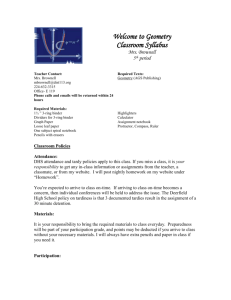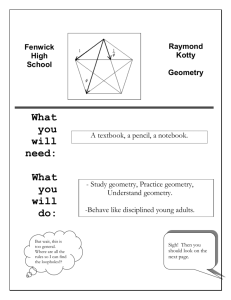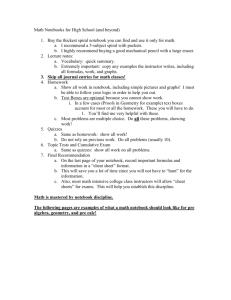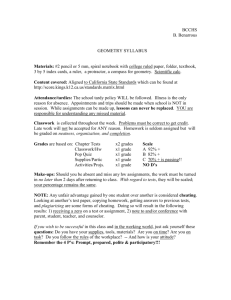Notebook for Math Structures
advertisement
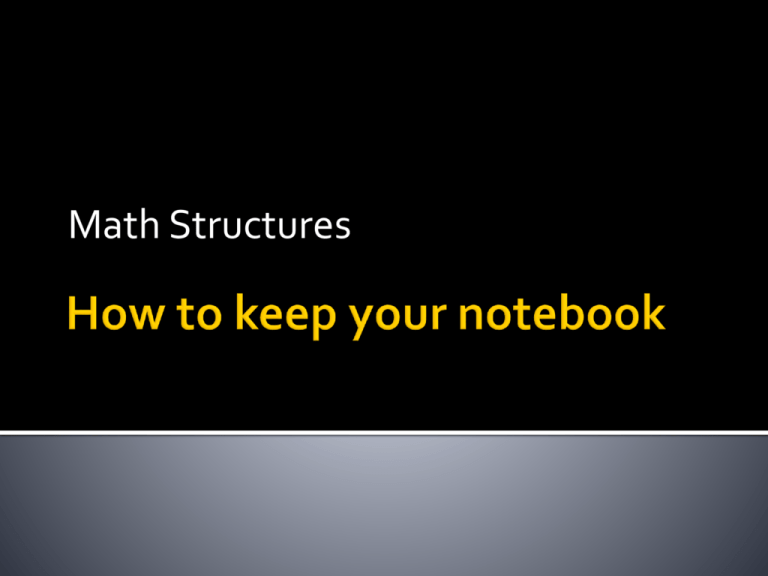
Math Structures
1) Use a loose leaf binder. NO SPIRAL TYPES!
2) Have plenty of notebook paper and pencil.
3) Put your syllabus in the back.
4) All handouts go behind the syllabus unless
they are worksheets that you’ve worked.
5) Bring your notebook to class.
3-ring binder
6) Keep all papers in order.
7) Keep papers from
other classes, OUT!
All problems from online homework should
be written legibly, in order, and numbered.
All that you might be tempted to call “scratch
work” is important in this class. It shows you
are working the problems yourself.
Duh…may I
scratch my
head?
Math Structures II Chapter 11 Study
Guide
Section 1
630
1. In what country could we stay that
geometry got started?
2. Who came up with an approximation
for pi?
3. What kind of geometry skill might be
expected of grades 3-5? Pre-K-3? 6-8?
631
1. Would an elementary aged student
be ready to do formal deductive proof?
2. Who was Euclid and what did he do?
632
1. What are the fundamental building
blocks of geometry?
2. Why must there by undefined terms
in geometry?
3. How are points and lines symbolized
in geometry?
You will download the study guide for
each chapter from my webpage in the
PCCUA website. This is the sequence:
Pccua – faculty & staff – directory –
gookin – student resources
You may then print it out, punch holes to
put it in your 3-ring binder, and
answer the questions on notebook
paper.
Or you may copy and paste the study
guide into Word and space it out so
you will have more room for the
answers on the study guide, then
.
print out the study guide with your
answers.
Math Structures II Chapter 11 Study Guide
Section 1
630
1. In what country could we stay that geometry
got started?
2. Who came up with an approximation for pi?
3. What kind of geometry skill might be expected
of grades 3-5?
Pre-K-3?
6-8?
631
1. Would an elementary aged student be ready to
do formal deductive proof?
2. Who was Euclid and what did he do?
632
1. What are the fundamental building blocks of
geometry?
2. Why must there by undefined terms in
geometry?
3. How are points and lines symbolized in
geometry?
The study guide at left was copied then
pasted into Word so that the student
can space as needed to answer the
questions. She can then either print
it out with her spaces and fill in with
pen, or type in her answers and print
that out. Punch holes and put in
notebook.
Be sure to make an honest attempt to
answer all questions and work through
the examples in the text.
.
Your chapter test is mainly over the study
guides.
Taking notes from online
videos is optional, but
they do help on your
notebook grade.
Be sure to label “Section #
video notes.”
Date is optional.
You may also take notes
from online powerpoints.
(Optional)
Section 11.1 video notes
Write using set notation
N = { 1, 2, 3, …}
W = { 0, 1, 2, 3, …}
J = { …-3,-2,-1, 0, 1,2,3…}
Q = { p/q| p and q are integers}
Section 11.1 powerpoint notes
The opposite of a number is like 4
and -4. zero is its own opposite.
A number and its reciprocal will
multiply together to get 1.
Section 11.1 OLHW
1) 2x – 3y = 6
x= 2y
Feb. 25
2(2y) – 3y = 6
4y – 3y = 6
y=6
x = 2(6) = 12
(12, 6)
2)
3) 6x – 3y = 0
3) 2x + 3y = 8
8x
=8
x=1
4)
6(1) – 3y = 0
-3y = -6
y=2
(1,2)
On left, write section # and
OLHW (for online homework)
Show all work, number your
problems, and be orderly.
You may just put a check mark by
problems you could answer
without work, such as a multiple
choice or short answer.
Work that must be done to
determine a graph should be
shown on your notebook paper.
(see next slide)
Heading
on each
page
Number
your
problems
Section 1.4 OLHW
5.) Graph 2x + 3y = 12
If x = 0 then 3y = 12 so y = 4
(0, 4) is on the graph.
If y = 0 then 2x = 12 so x =6
(6,0) is on the graph
Use graph paper if
doing classwork, extra
credit, or quiz, but you
may freehand sketches
that you transfer to
online homework.
Show your work on
how you determined
points on the graph.
Transfer graph to
online if needed.
Extra problems that you may work
from the textbook as suggested
on the study guides should also
be appropriately labeled. These
are optional as well. You must
write the section number and
number all problems.
Section 11.1 problems from text
A
1. (-2)2 = -4
March 14
2. (-8)/(-2) = 4
B
1. (-3)(-4) = 12
3. (-3) + 1 = -2
5. 24 – (-2) = 26 7. -3 – (-5) = 2
9. 54 -68 = 14
11. 6 + (-2) = 4
1.
Check
your work
Go on and fill up each page
with your math work.
Never use math websites on the internet to do your math problems for you.
Phones or ipads may never be
used for calculating in this class.
Most any calculator you have
may be used in this class.
Developing an orderly notebook and keeping accurate records of your work is
an important life skill, but it also gives credence to your efforts in this class.
Ten percent of your grade is the notebook.
Much educational research lately has confirmed the value of keeping
a good notebook.
Student success in this course will depend on learning how to keep a
notebook and using it.
MAY YOU HAVE GREAT SUCCESS IN THIS CLASS.
